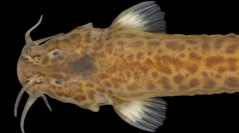

 Zoosystema
43 (28) - Pages 659-690
Zoosystema
43 (28) - Pages 659-690During a field inventory in the southeastern nucleus of the Serra Geral, southern Brazil, ten undescribed species of Cambeva Katz, Barbosa, Mattos & Costa, 2018 were found in a small area of about 2800 km2. These species are herein formally described: Cambeva diffusa n. sp., Cambeva duplimaculata n. sp., Cambeva grisea n. sp., Cambeva imaruhy n. sp., Cambeva longipalata n. sp., Cambeva notabilis n. sp., Cambeva orbitofrontalis n. sp., Cambeva panthera n. sp., Cambeva pericoh n. sp., and Cambeva urubici n. sp. They are diagnosed based on external morphology and osteological characters, which indicate that they belong to five intrageneric lineages. Most species occur in small areas, and some are rare. Five of these species here described are endemic to the upper Rio Uruguai basin, in a western open plateau belonging to the Araucaria Forest biogeographical province, and other five to the Rio Araranguá and Rio Tubarão basins, in the eastern forested plateau belonging to the Brazilian Atlantic Forest biogeographical province. The reported data suggest that some lineages are adapted to live in specific altitudinal zones, including the occurrence of three new species closely related to C. tropeira (Ferrer & Malabarba, 2011) found between 905 and 1325 m asl, contrasting with C. brachykechenos (Ferrer & Malabarba, 2013) and Cambeva grisea n. sp. found between 155 and 300 m asl. Finally, we compare the studied area to another mountain area, the Maciço de Itatiaia nucleus of the Serra da Mantiqueira in south-eastern Brazil, where a high number of endemic species have been recorded.
Araucaria Forest, Atlantic Forest, Mountain biodiversity, Osteology, Rio Araranguá, Rio Tubarão, Rio Uruguai, new species